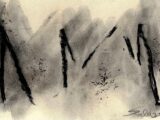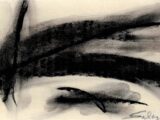DNA SHADOWS
DNA Shadows
My series DNA Shadows displays 100 images on natural Stonehenge paper using charcoal and resin, mixed and with polyurethane spray coating.
I produced a video, DNA Shadows, selecting the first 5 images in each category I assigned; example, Category 1 Alpha, 25 images in this category, and I used the first 5 mages in the video. Next Category is Beta, same the first 5 images from the 25 in the Beta Category; next Gamma, and next Delta. The video display 25 images with music added. This video of 25 images time run is 1.50; to provide a lengthy video for people to watch, my video would need to be professionally developed over time and expensive. I felt that a selection from the 100 was best for a test of how a video of the 100 series might look, and help in telling the story of the science in DNA.
The test video DNA Shadows, was my best option initially. The video was reviewed by Jim Kelly, aka Kelso: “I like it very much. Wonderfully and richly monochromatic. The blacks are very evocative and suggestive….from hard line to atmospheric softness. Moody and celebratory. A nice rhythm and pacing to the video.” See Vimeo Comments
The idea for the series as a video developed almost immediately; one of my DNA Shadow images (DNA #3) was selected by the UNH Art Museum, and it was in their group New England artists exhibit “On the Edge.” The show opened at the UNH Art Museum, in Durham, NH (Jan-April 2022) On my WordPress site I’m showing the lead image #1 from each ‘Category’ I used in the series; therefore Category One is Alpha (25 images); Category Two is Beta (25 images); Category Three is Gamma (25 images); and finally Category Four is Delta (25 images).
My shadow series on natural Stonehenge was done with a one-inch border of blue tape, this is used to keep the resin and the shadows within an image border of 5.5 x 9 inches, paper size, 7 1/2 x 11 inches: all 100 images are horizontal. I scanned these and then cropped each to the edge of the image; therefore, I managing to keep the original size intact, well almost so. Very little adjustment was made with image software on any image in the series.
I work extensively in series in almost all my art. I searched the Internet on “DNA shadows.” I followed the research and began writing material that I felt will be of public interest and support the shadow art in the series. I wanted the ‘images’ and the ‘stories’ around my title “DNA Shadows” to be comprehensible; therefore worthy displaying as a complete body of work on my website. I use my website to display my art making and use ‘words & images’ in finalizing the series.
I found on the Internet, an article published by United Academics Magazine in 2016, (Connect Science and Society) by Rita dos Santos Silva entitled “The Discovery of DNA Structure—Who stayed in the Shadows of a Nobel?” I thought it was ‘neat,’ that ‘shadows’ played a role in the discovery of DNA structure. Dr. Silva uncovered this interesting social fact around the DNA science discovery of DNA and the award of the Nobel prize to Drs.Watson & Crick.: “The discovery of the DNA molecule is often wrongly attributed to Watson and Crick. However, the DNA molecule was in fact first described by Friedrich Miescher. In 1869, this Swiss biochemist was trying to isolate protein components of white blood cells.” (From Rita dos Santos Silva)
Of special interest today, and most needed to be documented and made crystal clear, is how often women have been denied proper recognition, especially in the scientific community. A woman researcher, Rosalind Franklin was denied any recognition of her work by Watson and Crick, both these scientists, receiving the Nobel prize. Dr. Silva uncovers that “it wasn’t until Watson heard a lecture by Rosalind Franklin about X-ray images of DNA, that the discovery of the DNA structure was consolidated. Watson later admitted that he wasn’t truly paying attention to Franklin’s lecture, so he didn’t understand how her data could help his investigations.” “Allegedly, it was Wilkins that showed Watson the famous Photo 51 – an X-ray DNA image taken by Franklin’s assistant and used in her Nature article; she had published her research in Nature earlier. Watson recalls that, after seeing Photo 51, he had no doubts about the double helix DNA model. Franklin never gave permission to Wilkins to show Photo 51 and accusations of data theft are still raised when talking about the discovery of the DNA structure.”
“Two enthusiastic researchers get together in 1951, the same year Franklin joined the Kings’ College in London, a young and enthusiastic zoology graduate arrives at Cambridge. He starts working with Francis Crick, a brilliant graduate in Physics that shared Watson’s passion for genetics. Supported by Chargaff’s deduction of the DNA composition and Linus Pauling’s work on molecular models, Watson and Crick started to unravel the structure of DNA.” Source: The Guardian.

“However, it wasn’t until Watson heard a lecture by Rosalind Franklin about X-ray images of DNA, that the discovery of the DNA structure was consolidated. Watson later admitted that he wasn’t truly paying attention to Franklin’s lecture, so he didn’t understand how her data could help his investigations. “Allegedly, it was Wilkins that showed Watson the famous Photo 51 – an X-ray DNA image taken by Franklin’s assistant and used in her Nature article. Watson recalls that, after seeing Photo 51, he had no doubts about the double helix DNA model. Franklin never gave permission to Wilkins to show Photo 51 and accusations of data theft are still raised when talking about the discovery of the DNA structure.” Source The Guradian
Putting together the pieces of the DNA puzzle
“After being sure about the double-helical DNA structure, Watson and Crick started to work on the final calculations to prove their DNA molecular model. In 1953, they came up with their double-helix DNA molecular model, which remains practically unchanged until today. When Watson and Crick showed it to Wilkins and Franklin, the two were certain that the model was right and agreed that the discovery should be published solely under Watson and Crick’s names. Supporting data would be published separately by Wilkins and Franklin. On the 25th of April, the Nature journal published the paper where Watson and Crick first describe the DNA structure, A Structure for Deoxyribose Nucleic Acid, as well as Wilkins’ Molecular Structure of Deoxypentose Nucleic Acids and Franklin’s Molecular Configuration in Sodium Thymonucleate.
In 1962, Watson, Crick, and Wilkins received the Nobel Prize of Medicine and Physiology, for their “discoveries concerning the molecular structure of nucleic acids and its significance for information transfer in living material”. Franklin, who left King’s College due to the terrible environment, died of cancer 4 years before. In his acceptance speech, Watson refers that “Some [people] thought Maurice was very strange, and others, including myself, thought that Francis was at times difficult. Fortunately we were working among wise and tolerant people who understood the spirit of scientific discovery and the conditions necessary for its generation.” Source The Guradin
References
Leslie Pray (2008). Discovery of DNA structure and function: Watson and Crick Nature Education, 1 (1)
The Guardian – Sexism in science: did Watson and Crick really steal Rosalind Franklin’s data?
DNA From the Beginning
Image Credit: 40innovadoresbbva.com
Reference
The Violinist’s Thumb by Sam Kean; Little Brown & Company, July 201 A very easy read for all those who don’t need an in depth scientific analysis in DNA, but who are interested in the science enough to explore Sam Keane’s concise scientific presentation of DNA, written with a lighter literary touch, yet erudite on the subject. It’s a well documented book on DNA science, with the added value of exposing the roles played by the key figurers in uncovering DNA’s secret, and how this has changed our world for ever. Well worth reading! (Salazar)
Helix created with
https://stablediffusionweb.com/
DNA SHADOWS TEST VIDEO SEE: LINK: https://vimeo.com/manage/videos/671958033
https://vimeo.com/manage/videos/671958033
 Salazar
Salazar



